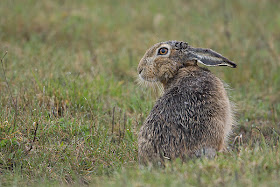 European hares started out in Europe, and that's how they got their name. Since then, they spread out into western Asia, and they also got introduced into some other places such as South America, Australia, New Zealand, and a little bit of the U.S. There are plenty of hares around, so they are not endangered. But farming has given them less land to live in, and some farmers think of them as pests because hares eat crops. So there is a lot of hunting of hares by people and also by predators such as eagles, foxes, coyotes, and wolves.
European hares started out in Europe, and that's how they got their name. Since then, they spread out into western Asia, and they also got introduced into some other places such as South America, Australia, New Zealand, and a little bit of the U.S. There are plenty of hares around, so they are not endangered. But farming has given them less land to live in, and some farmers think of them as pests because hares eat crops. So there is a lot of hunting of hares by people and also by predators such as eagles, foxes, coyotes, and wolves. |
| Dark red = original range Bright red = introduced areas |
European hares mostly hang out by themselves, unless it is the mating season. They come out around dusk, and they graze all night, and then they go to bed about dawn. In the summer, they eat grasses, herbs, and field crops. During the winter, they eat stuff like twigs, buds, and the bark off of shrubs and young trees. Two or three adult hares can eat as much as one sheep, which pretty much explains why farmers don't like having hares in their fields.
The breeding season for European hares is really long, like from January to August. But during this time a female hare is only ready to mate for a few hours during one day of a 6-week cycle. So when a female is ready, the males compete with each other to find out who gets to be the lucky guy. If a female isn't ready, she will fight off a male by boxing with him and biting his ears in a vicious way, which serves him right for being so pushy!
But then when a female is ready, she starts running really fast, with all the males chasing her. After a while, some males start dropping out of the race, and when there is only one left, that is the one who gets to mate with her.
All of this crazy mating behavior is called "March madness," which you might have thought was about basketball, but if you thought that, you were wrong! Of course, like I said, the mating goes on for several months, but in March and April it's the craziest.
The baby hares, who don't have a burrow to protect them, are born with hair, and they are able to do a lot of stuff very soon after birth. The mother hare puts some babies in one form and some in another, farther away, just so a predator won't get all of them at once. Then she travels around from form to form to nurse the babies. By the time they are a month old, the young hares can get along all by themselves.
So that's the story of European hares, except I forgot to mention that they can run as fast as 35 miles per hour. Oh, and did you know that the original Easter Bunny was a European Hare?




No comments:
Post a Comment